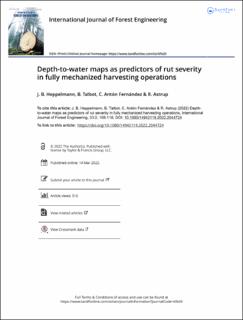| dc.contributor.author | Heppelmann, Joachim | |
| dc.contributor.author | Talbot, Bruce | |
| dc.contributor.author | Antón Fernandéz, Clara | |
| dc.contributor.author | Astrup, Rasmus Andreas | |
| dc.date.accessioned | 2022-10-31T13:43:46Z | |
| dc.date.available | 2022-10-31T13:43:46Z | |
| dc.date.created | 2022-09-30T09:40:55Z | |
| dc.date.issued | 2022-03-14 | |
| dc.identifier.citation | International Journal of Forest Engineering. 2022, 33 (2), 108-118. | en_US |
| dc.identifier.issn | 1494-2119 | |
| dc.identifier.uri | https://hdl.handle.net/11250/3029170 | |
| dc.description.abstract | The preservation of the functionality of forest soil is a key aspect in planning mechanized harvesting operations. Therefore, knowledge and information about stand and soil characteristics are vital to the planning process. In this respect, depth-to-water (DTW) maps were reviewed with regard to their potential use as a prediction tool for wheel ruts. To test the applicability of open source DTW maps for prediction of rutting, the ground surface conditions of 20 clear-cut sites were recorded post harvesting, using an unmanned aerial vehicle (UAV). In total, 80 km of machine tracks were categorized by the severity of occurring rut-formations to investigate whether: i) operators intuitively avoid areas with low DTW values, ii) a correlation exists between decreasing DTW values and increasing rut severity, and iii) DTW maps can serve as reliable decision-making tool in minimizing the environmental effects of big machinery deployment. While the machine operators did not have access to these predictions (DTW maps) during the operations, there was no visual evidence that driving through these areas was actively avoided, resulting in a higher density of severe rutting within areas with DTW values <1 m. A logistic regression analysis confirmed that the probability of severe rutting rapidly increases with decreasing DTW values. However, significant differences between sites exist which might be attributed to a series of other factors such as soil type, weather conditions, number of passes and load capacity. Monitoring these factors is hence highly recommended in any further follow-up studies on soil trafficability. | en_US |
| dc.language.iso | eng | en_US |
| dc.publisher | Taylor & Francis | en_US |
| dc.rights | Attribution-NonCommercial-NoDerivatives 4.0 Internasjonal | * |
| dc.rights.uri | http://creativecommons.org/licenses/by-nc-nd/4.0/deed.no | * |
| dc.title | Depth-to-water maps as predictors of rut severity in fully mechanized harvesting operations | en_US |
| dc.title.alternative | Depth-to-water maps as predictors of rut severity in fully mechanized harvesting operations | en_US |
| dc.type | Peer reviewed | en_US |
| dc.type | Journal article | en_US |
| dc.description.version | publishedVersion | en_US |
| dc.rights.holder | © 2022 The Author(s) | en_US |
| dc.source.pagenumber | 108-118 | en_US |
| dc.source.volume | 33 | en_US |
| dc.source.journal | International Journal of Forest Engineering | en_US |
| dc.source.issue | 2 | en_US |
| dc.identifier.doi | 10.1080/14942119.2022.2044724 | |
| dc.identifier.cristin | 2057025 | |
| dc.relation.project | EC/H2020/720757 | en_US |
| cristin.ispublished | true | |
| cristin.fulltext | original | |
| cristin.fulltext | original | |
| cristin.qualitycode | 1 | |

